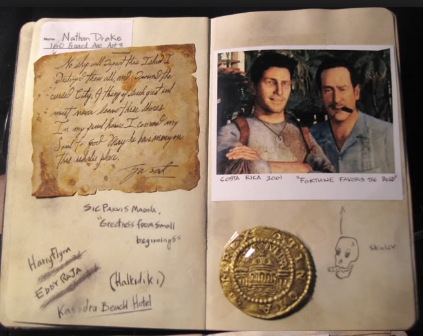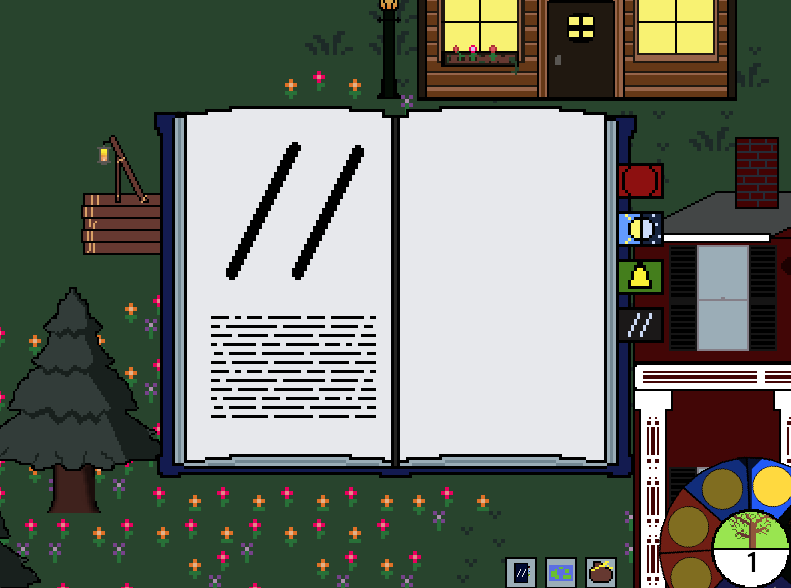Welcome to another edition of Feature Friday! Yet again we’re taking a deep dive into one of the many features and systems you can find in Village Monsters
Today, I’ll be outlining the mighty compendium. Let’s take a look.

Much of your time will be spent in the cozy confines of the village – talking with people, attending events, upgrading your house, and so on.
But the world outside the village is even larger and full of things to explore, treasure to find, puzzles to solve, and much, much more. With so much to see and do on a given day, how do you keep track of it all?
The answer is with your compendium
Inspiration
Before I go much further I want to talk a bit about what has inspired me with regard to the compendium.
My favorite video game series is without a doubt The Legend of Zelda . Of them all, Majora’s Mask is the one that sticks with me the most. There’s no shortage of things to praise about that game, but for me the biggest draw is Clock Town.
It’s become something of a cliche to talk about NPCs that feel “alive” and well-realized, but Majora’s Mask has set a bar that few games have met in the decades since. Every single NPC has their own schedule, things to learn about, and problems to solve.
Similar to my game, Majora’s Mask needed a way for you to track it all, and it did so via the wonderful Bomber’s Notebook.

The thing I enjoy the most about the Bomber’s Notebook is how it starts out empty, requiring you to fill it out by observing people and talking to them. As such, filling out the notebook was not only a practical solution to finding heart pieces and masks, but was also surprisingly satisfying – in some ways, you felt like a detective.
This is the overall structure I’m aiming for with the compendium. I want you to also feel like a detective in Village Monsters as you observe things, talk to people, take notes, and gradually expand your knowledge of this world.
But what about the overall style? One issue I always had with the Bomber’s Notebook is that it felt very video game-y – I never actually felt like I was looking at a book.
To avoid this, I’m trying to base the compendium’s style on a traveler’s journal. If you’ve ever searched for notebooks online you’ve probably seen some version of the “well-worn traveler’s journal”. You know, something like this:

There’s something oddly alluring about the idea of a travel journal or log. It begins blank and clean, and over time it’s filled in with text, pictures, scribbled notes and doodles and dog-eared pages. It becomes its own living recording of your time and place.
It’s also incredibly hard to muster the motivation and time to make one in real life, but in a video game? Well, the compendium will do all the heavy lifting for you, making it much easier to maintain.
Sections

The compendium is not just for people looking to track and complete their collections – it’s a vital tool used throughout the entire game.
To make it all manageable, it’s been split up into various sections to better organize all the information it stores. In total, there are 5 sections: Calendar & Events, Villagers, Mysteries, Lore & History, and Collections.
Calendar & Events
This section is the simplest, and serves as a basic reference guide to upcoming events and holidays. Use it to plan out your days and weeks to ensure you won’t be missing anything important.
You can also set your own reminders and notes here.
Villagers
The Villagers section keeps tabs on each villager you meet. It records details like their schedule, preferences, relationships, and more. This will become increasingly vital as you rely on building relationships to advance the story, improve the village, and solve problems.
At first, this section is will be completely blank. To fill it out you must meet new villagers, talk with them, solve their problems, and so on.
Mysteries
In Village Monsters, you can think of “Mysteries” as being very similar to quests. However, unlike quests they have the habit of being more complex and requiring more time to complete on average. Said a different way, mysteries tend to be a long term affair.
To keep track of it all, an entire section in your compendium is dedicated to all mysteries that you’re following. You’ll be able to see how the mystery started, the villagers involved, and your latest findings.
Lore & History
The world is big and there’s a lot to find out there. All knowledge that you learn about the various areas of the world will be recorded here. This includes area and item descriptions, key historical figures and events you learn about, and more.
Like the Villagers tab, this section will start out empty and must be filled in through some light detective work. You’ll want to put in the effort, though, as the various tidbits of lore and context may help you considerably when it’s time to solve the many puzzles out there.
Collections
From fish to bugs to treasure to artifacts, there’s a lot to collect, and the Collections tab is where you track it all.
Use this section to admire all that you’ve caught in time with the game. As you fill out the details you’ll also better understand the gaps in your collection, so refer back often to see what you’re missing.
The Future
I have only a basic prototype of the compendium currently implemented, but by the next Were-Release (“Crow”) I should have it completed for you to check out.
I’ll have more to share in the coming months as the rest of the game is fleshed out. Stay tuned!
Leave a Reply
You must be logged in to post a comment.